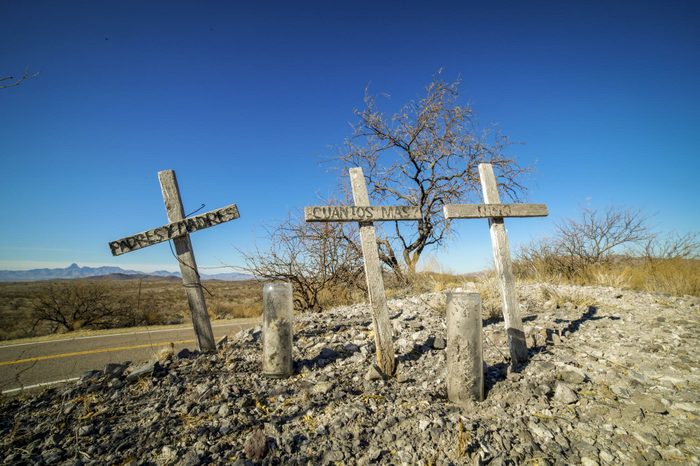Biden's Invisible Border Wall
The Biden administration is expanding surveillance along the Southern border, pushing migrants into harm’s way.
Maurizio Guerrero

Alone and undocumented, a 24-year-old Mexican man named Joel crossed from Mexico into the dense sand and brush of southern Texas on Oct. 1, 2015, a perilous and exhausting slog. After three days without food, lost and cold, he dialed his sister on a cell phone, saying he had passed a river two hours earlier and then a hunter’s cabin. It was the last time anyone would hear from Joel.
Joel’s sister immediately alerted U.S. Customs and Border Protection (CBP) about her brother’s dire state, but the agency refused to launch an emergency search, she says, and her subsequent calls to 911 were redirected back to CBP. To this day, Joel has not been found.
No More Deaths, a humanitarian aid organization, contends that Joel, whose name is a pseudonym, was a victim of a CBP policy known as Prevention Through Deterrence. Adopted in 1994, the policy closed off common points of entry, nominally dissuading migrants from entering the United States but actually just pushing them into remote and often deadly corridors.
Though Biden has pledged a more humane approach to immigration, his administration has kept this brutal “deterrence” policy in place, continuing to construct autonomous surveillance towers along the U.S.- Mexico border. These towers, which stand 33 feet tall and are equipped with night-vision cameras and radar, detect and classify all moving objects. To avoid the towers, migrants often take circuitous (and dangerous) routes.
“[There] is a significant correlation between the location of border surveillance technology, the routes taken by migrants, and the locations of recovered human remains in the southern Arizona desert,” University of Arizona geospatial scientist Samuel Norton Chambers concluded in a January 2019 study. These technologies, Chambers found, create a “funnel effect” that channels border crossers into deadly routes.
While Biden canceled the Trumpian expansion of the border wall, his proposed federal budget for the upcoming fiscal year calls for $291 million in additional funding for Border Patrol (about a 6% increase from fiscal year 2021), in part to expand border surveillance. According to the American Immigration Council, if this proposal is approved, it would be the first time the agency’s budget has exceeded $5 billion, adjusted for inflation.
“Basically, none of the current technologies are being discontinued by the Biden administration — e.g., artificial intelligence, autonomous towers, camera surveillance systems, etc. — and the funding levels look similar if not higher in some areas,” explains Julie Mao, co-founder and deputy director of Just Futures Law, which provides legal support for migrants facing deportation.
Mao believes Congress will approve the request. “I don’t think the numbers will deviate much, and sometimes Congress provides more money than [CBP] requests when it comes to surveillance tech,” she says.
The Biden administration has made no move to cancel a 2014 contract worth up to $239 million (which runs through October) with EFW Inc., a subsidiary of the Israeli arms manufacturer Elbit Systems. (Elbit has also constructed an electronic fence and “smart” towers for Israel’s separation wall in the West Bank and produced an array of weapons used to attack Palestinians in Gaza.)
The administration is similarly honoring an up-to- $250-million agreement with another leading manufacturer of border surveillance towers, Anduril Industries, founded by Palmer Luckey, a billionaire, Trump donor and co-founder of the virtual reality technology company Oculus. That deal extends until 2025. The administration also appears to be honoring a $36.9 million contract with Anduril that expires in 2022.
Surveillance towers like Anduril’s have proliferated along the U.S.-Mexico border at an astonishing rate. Since CBP debuted four of these structures in San Diego County in early 2018, the agency has commissioned 56 more with plans to install another 140 by October 2022.
The Biden administration signaled its intention to renew border surveillance contracts worth several hundred million dollars as early as March, when it updated a draft request to acquire additional “integrated surveillance towers.” The administration’s stated goal is to “detect, track, identify and classify” moving objects — but as with the other towers, their effect will be to push border crossers into isolated areas.

As of September 2019, CBP reports it has recovered the remains of 7,805 people from the Southwest borderlands since the late 1990s, but advocates estimate that Prevention Through Deterrence has killed or disappeared as many as 80,000. Despite the enormous human toll, the Biden administration appears committed to this deterrence strategy, effectively substituting surveillance towers for a physical wall.
The new budget requests and contract renewals also align with the administration’s immigration reform plan, introduced in January, which calls for “smart border controls” that rely on “flexible solutions and technologies that expand the ability to detect illicit activity, evaluate the effectiveness of border security operations, and be easily relocated.” That neatly describes Anduril’s mobile towers, which function in tandem with autonomous drones across the border.
Hoping to “educate” Congress about the need to expand its autonomous surveillance tower program, Anduril spent $260,000 in lobbying during the first quarter of 2021 — roughly half of what it spent the entire 2020 fiscal year. Of the 17 lobbyists the company hired, 12 are former government officials, according to OpenSecrets.
This revolving door between the public and private sectors has created what investigative journalist Todd Miller calls a “border-industrial complex” that gives companies like Anduril “tremendous influence” over the government’s short- and long-term strategies. The 13 top Department of Defense contractors working at the border contributed nearly three times as much to the Biden campaign ($5,364,994) as they did to Trump ($1,730,435).
In an open letter published February 25, a coalition of 40 border community, immigrant rights and civil liberties organizations (including Mijente, Rio Grande Valley Equal Voice Network, Rio Grande Valley No Border Wall Coalition, Southern Border Communities Coalition and Just Futures Law, among others) took aim at the Biden administration’s pursuit of a “smart border.”
“This ‘smart border’ surveillance technology is a continuation of the Trump administration’s racist border policies,” the letter reads, “not a break from it.”
Biden’s embrace of border tech mirrors that of Congressional Democrats, but a few progressives appear willing to dissent. In 2019, Rep. Alexandria Ocasio-Cortez (D-N.Y.) called for the abolition of the entire Department of Homeland Security, which includes CBP. In a June 2 online forum hosted by Just Futures Law and Mijente, Reps. Raúl Grijalva (D-Ariz.) and Rashida Tlaib (D-Mich.) voiced concern about border surveillance, even if they haven’t formally condemned the Biden administration’s so-called smart border.
The lives of migrants depend on the sustained resistance against these technologies and against Prevention Through Deterrence. In 2020, the International Organization for Migration registered the deaths of nearly 500 people trying to cross the U.S.-Mexico border. This year’s death toll stands at 133 as of June 28. The real numbers are likely higher, as many deaths go unrecorded.
When migrants are in crisis, “volunteers spend hours and hours calling different numbers and being redirected, often resulting in dead ends,” says Parker Deighan, of the group No More Deaths. “The Biden administration has spoken of increasing the very militarization that leads to these emergencies in the first place.”
Maurizio Guerrero is a journalist based in New York City. He covers migration, social justice movements and Latin America.









